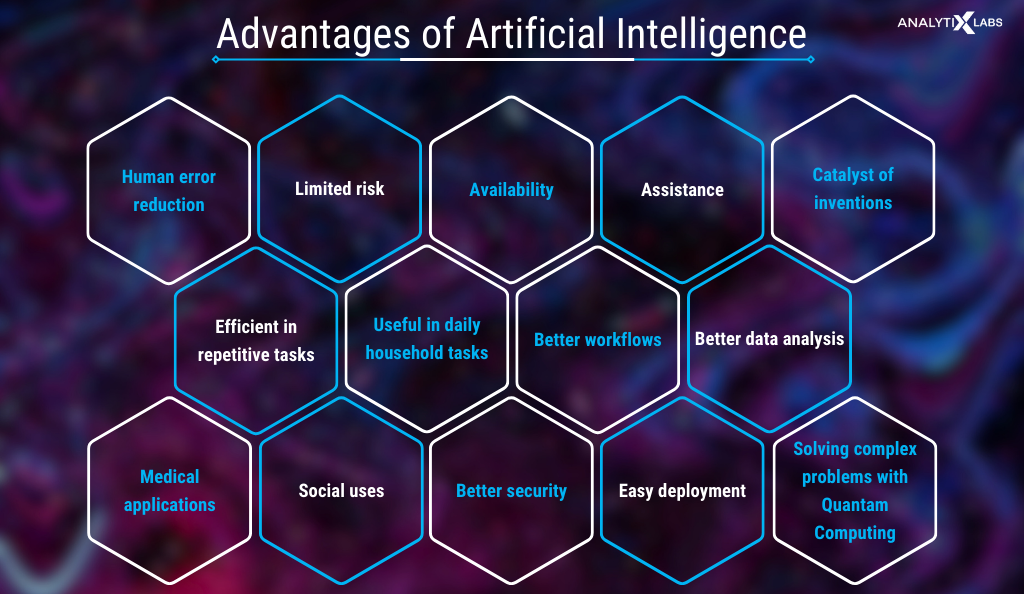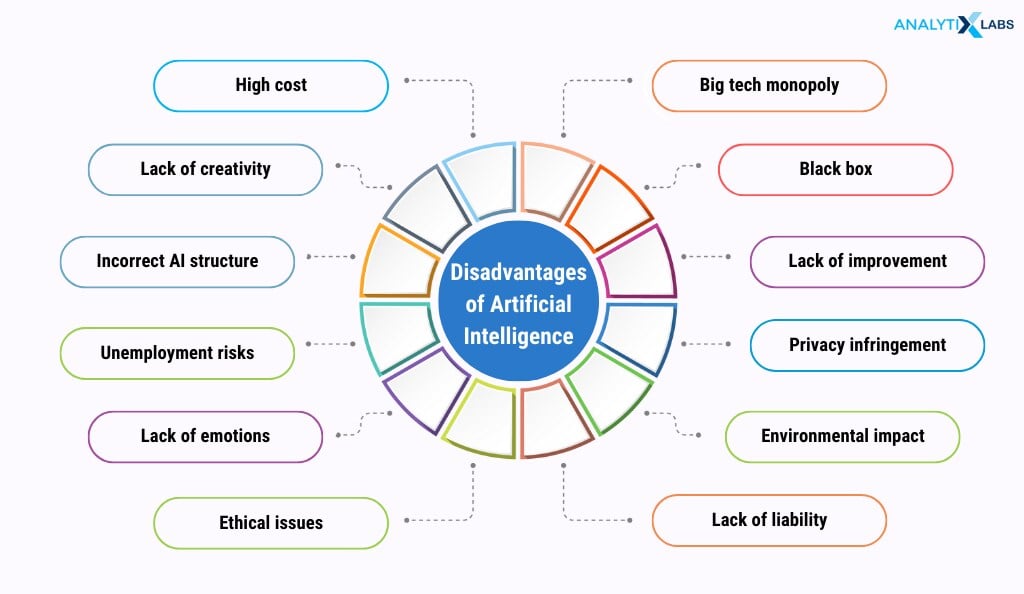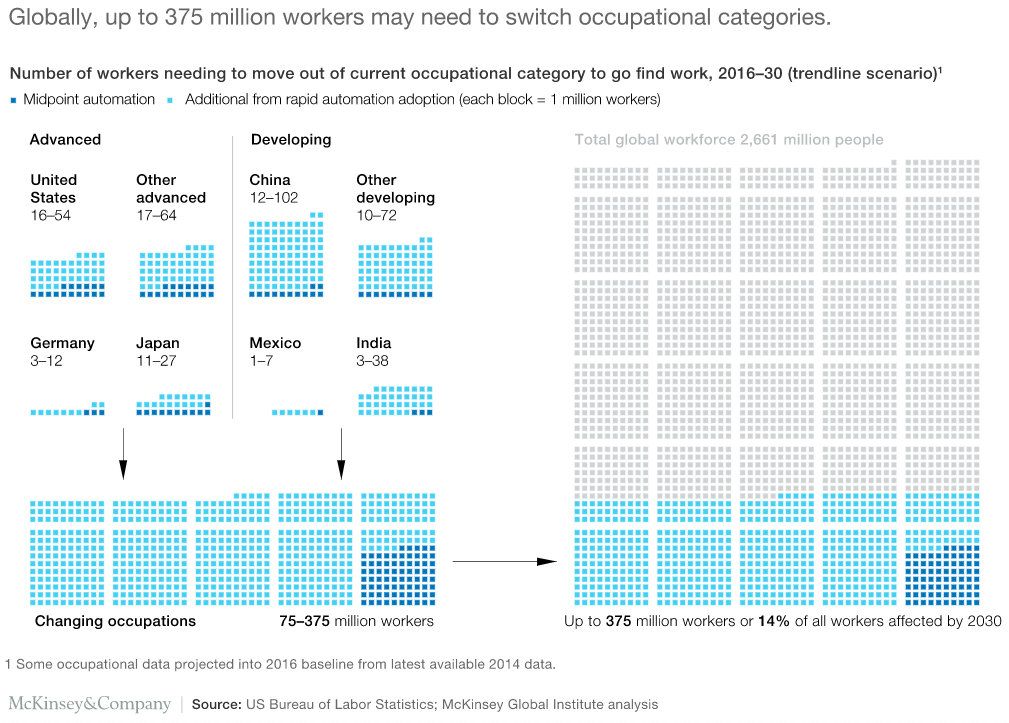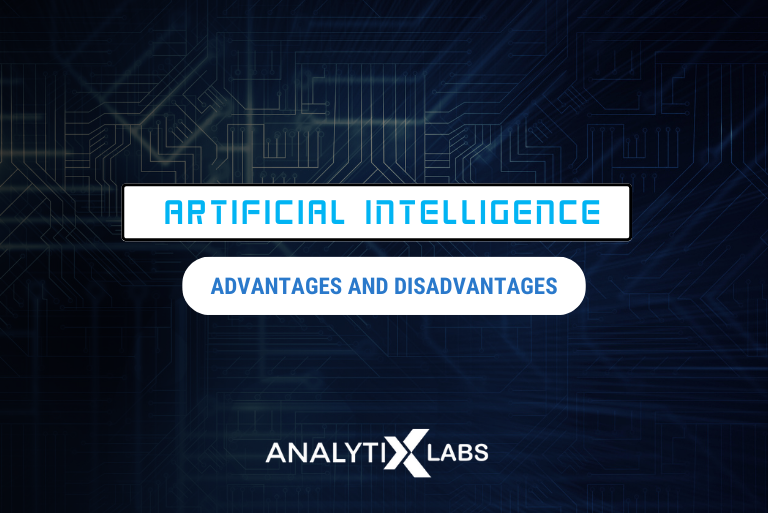Artificial Intelligence (AI) does not belong to the future – it is happening now. AI is being adopted rapidly, with its use being found in every other product and domain. This sudden adoption of AI has caused a transformation in our lives, given the merits and demerits of AI.
Invented by John McCarthy in 1950, Artificial Intelligence, or AI as it is commonly called, is the capability of machines to perform tasks like humans, especially in intelligent decision-making. Therefore, the bottom line of AI is that a machine can perform tasks intelligently like humans without being explicitly instructed on how to perform a task.
Modern-day AI systems employ several techniques (also considered AI sub-domains) to perform tasks like humans. These include natural language processing (NLP), computer vision, machine learning, deep learning, the use of big data stores to answer complex questions, etc.
Companies’ widespread adoption of AI has resulted in a significant problem: the blind utilization of AI without a complete and comprehensive understanding of its benefits and drawbacks. Reckless implementation of AI has often disregarded its negative aspects. Hence, this article aims to introduce you to the pros and cons of AI, enabling you to make well-informed decisions regarding its usage.
You may also like to read: Artificial Intelligence Engineering
Artificial Intelligence: 4 Major Stages of Development
It is imperative that AI has enabled machines to understand verbal commands, distinguish images and texts, and do much, far better than a human. For instance, Amazon’s Alexa, Apple’s Siri, or Google’s Hello Google. These are examples of artificial intelligence that easily takes in verbal commands and performs them.
Given the rate at which machine learning, deep learning, National Language Programming, predictive AI, and other related concepts are growing, it isn’t a mere hallucination to predict that machines will walk amongst us one day, replicating all human behaviors with panache.
The current AI systems can handle complex calculations at a tremendous speed. They can handle huge data sets and make accurate predictions. Artificial Intelligence is majorly classified into four stages considering its development or refinement:

-
Reactive machines
These are those machines that do not store any memories or any past experiences. It is ‘reactive’ in nature that reacts to the current scenario. Reactive machines have limitations because they lack the ability to reason or consider the context beyond the immediate input.
One prominent example of reactive machines is Deep Blue, the chess-playing supercomputer developed by IBM. Deep Blue relied on a brute-force search algorithm to evaluate millions of possible moves at each turn and choose the best one. However, it did not learn or improve its performance over time based on past games or experiences.
-
Limited memory
This type of machine can peak into the past. A self-driving car is an example of a reactive machine in AI. They use a variety of sensors and real-time data to make instant decisions and react to their surroundings with no memory or past context.
These devices assess the current status of the road and then perform appropriate actions based simply on the current input. However, these information pieces are transient in nature rather than permanent.
-
Theory of mind
This type includes machine learning that tries to replicate the entire physical world – humans, creatures, objects – everything that can think and has emotion.
Virtual assistants and chatbots are fantastic examples of the theory of mind. AI systems with the Theory of Mind can reply to human queries and requests more context-awarely, going beyond simple pattern recognition. They may deduce the user’s intentions, feelings, and mental states from their input and respond more personally and compassionately.
-
Self-awareness
This is the type wherein machines will have systems that can allow them to be self-conscious. This stage also extends the Theory of Mind stage wherein machines will have self-awareness for a ‘reason.’ This will take machines to a whole new level of intelligence.
While AI researchers have a long road to tread before self-conscious machines come into play, current AI scientists focus on honing the machine-learning skills of these computers. Enabling machines to respond more like humans are getting better each day.
Also read: How Artificial Intelligence Future Will Shape the Human World
Advantages and Disadvantages of Artificial Intelligence (AI)
The benefits of Artificial Intelligence are clearly visible in the form of AI-enabled chat support for brands, auto-search on search engines, smart predictions on eCommerce platforms, and more. Yet, many cons of AI cannot be ignored.
Below are the major advantages and disadvantages of artificial intelligence. Let’s start with the advantages of artificial intelligence first.
Advantages of Artificial Intelligence

-
Human Error Reduction
This is why artificial intelligence has been adopted in various domains. When you can nullify human errors completely, you get accurate results. The catch is to program properly.
Machines make accurate decisions based on the previous information that they gather over time while applying certain algorithm sets. Thus, there is a reduction in error and a spike in accuracy.
For instance, Google shared an update of the “Universal Speech Model (USM)“, an AI model to support 1000 most spoken languages.
Currently, this model has achieved the goal of supporting 100+ languages now. It can now perform automatic speech recognition (ASR) of not only popular languages but also under-resourced as well. The errors in human translations will now be reduced to even zero with this model.

-
Zero risks
The main impetus behind introducing AI has been to replace humans with tasks that machines can do better or help in other ways. One of the advantages of ai is that it helps reduce risks associated with specific tasks. These tasks range from bomb defuse, fuel exploration, and mining to space exploration.
Several places on earth and outside are highly unfriendly to humans and can risk the lives of people working there. Here AI-enabled machines can reduce the risk to lives and do the work with high precision.
It can be profitable to use machines to perform activities when humans may be in risk. For instance, enabling machines to deal with natural calamities can result in faster recovery and lesser pressure on human teams. In this regard, Artificial Intelligence greatly detects calamities like earthquakes using early warning systems. This provides time to reduce the losses and help people evacuate faster.
-
Round-the-clock availability
Fatigue is an essential human behavioral component that needs to be considered when planning timelines for completing a task. This is because the maximum productivity of any human is between 3-4 hours a day, and working beyond this gradually reduces their productivity due to lack of concentration and tiredness. Also, humans cannot be available 24 x 7 for performing a task.
On the other hand, an AI-enabled machine can work as well as a human all the time with the same level of precision.
Google has its Contact Center AI for businesses to improve customer experience. This is a classic example of an AI-enabled helpline system for businesses to relentlessly address customer queries and issues and resolve them on priority for improved customer experience.
Similarly, Amazon Lex, the chatbot designed for call centers by Amazon, can have intelligent conversations against human queries. It incorporates the same Amazon Alexa technology- i.e., recognizing the caller’s intent, asking related follow-up questions, and providing answers. These chatbots are available round-the-clock, catering to customers across the globe and varied timezones seamlessly.

-
Efficient in Repetitive Tasks
As discussed above, due to its availability rate and level of accuracy, AI has become the ideal choice to automate repetitive tasks. These tasks are especially prone to human error as they are not dynamic and require you to perform the same job repeatedly, inducing boredom in the person doing the task.
Also, these tasks are often pretty well defined, and AI can easily do that in a fraction of the time and cost. Examples like electronic application forms, evaluation of MCQ answer sheets, data entry, packaging, and assembly of parts in manufacturing are some of the domains where AI is increasingly used.
-
Better Workflows
Increase in efficiency at workplaces is from the many advantages of artificial intelligence. This is mainly due to the saving of time and cost. Coupled with modern-day AI’s accuracy, this leads to a better, more cost-effective workflow.
For example, technologies like automated speech recognition (ASR) and natural language processing (NLP) have led to better workflows. As transcripts become readily available, helping the judicial process or going through a lot of text data, such as testimonies, to find evidence and clues have helped the police department solve crimes. All these minor improvements help the overall workflow of departments.
-
Better Data Analysis
Going through voluminous data to detect patterns can be a tedious task. There can always be a possibility of losing out on some patterns, or because of the time and cost constraints, the analysis cannot be done deeply.
Here there is an advantage of AI as it can, with an appropriately trained algorithm, surface significant trends, reveal crucial information, and even recommend solutions helping in informed decision-making.
-
Medical Applications & Healthcare
AI has revolutionized the field of medicine by helping to develop various systems for the early detection of diseases like cancer. AI has also helped the healthcare industry in general. For example, AI models can help health insurance companies determine the future complications of an applicant and suggest a health plan accordingly.
-
Social Uses
The role of AI in helping society, in general, cannot be discarded. AI has helped in natural disaster response by assisting concerned departments in managing problems like an outbreak of deadly diseases to wildfires.
In the field of education, AI has helped through adaptive learning. AI has also impacted the field of agriculture as it provided farmers with early detection of crop diseases, assisting them in mitigating risks of crop failures, etc. In addition, AI is also being increasingly used to limit the spread of fake news and rumors.
-
Better Security
AI has greatly helped make countries’ internal and external security more robust. In modern warfare, the use of AI enables a swarm of drones to confuse the defense system of the enemy country and borrow time for the on-foot troops to invade. Regarding internal security, AI-enabled CCTV cameras and auto-flagging social media posts and messages have led to the early detection of anti-social activities.
-
Easy Deployment
Among the less talked about advantages of AI is the ease with which individuals starting in the field of AI can implement it and its associated technologies. Today, an AI model performing complex tasks can be created by writing merely 30 lines of code.
Unlike the early implementation of AI in the 50s and 60s, modern-day AI is democratized and can be implemented by even those with a surface knowledge of this field.
-
Solving highly complex problems with Quantum Computing
A lot of basic questions, like the origin of the universe to various fundamental physics questions, require molecular modeling that is highly computationally expensive. The next giant leap for AI can be its integration with quantum computing, as this will give AI the type of computational fuel that will help it solve problems that have stayed unanswered for decades.
With all these advantages of ai, there are still serious concerns that you should keep in mind when implementing it. Few of these concerns can be comprehended by understanding the disadvantages of ai as discussed ahead.
-
Catalyst of inventions
As mentioned in the beginning, AI has revolutionized the world. As people saw it in the ’60s, the dream of AI has become a reality. This has led to many new inventions, with AI at its center. These new inventions have ranged from self-driving cars to an increasing role in flying airplanes.
-
Use in daily household tasks
AI is a technology that is not only reserved for doing high-stakes tasks but has found its way into our homes, helping us perform daily tasks. The Internet of Things (IoT) has also aided in this.
Also read: Role of IoT in Big Data
Today, applications like Siri, Alexa, and Cortona and devices like Amazon Echo and Google Home have taken over daily household tasks, from switching on the TV to checking the weather.
-
Enhanced assistance
AI has also helped in assisting us on various occasions. This assistance has often been in the form of chatbots helping us resolve our problems without delay.
Different devices created around voice assistance have allowed us to perform tasks that required a personal assistant earlier. These include taking notes, creating meeting minutes, scheduling and reminding us of meetings, etc.
If you are planning to get a certificate course in artificial intelligence, which incorporates the core concepts required to build these amazing bots, get started today with AnalytixLabs, because, trust me, there has never been a better time than today to get into AI.
You can also refer to some of our blogs to plan your learning journey with AI!
With all these advantages of artificial intelligence, there are still serious concerns that you should keep in mind when implementing it. Few of these concerns can be comprehended by understanding the disadvantages of ai as discussed ahead.
Disadvantages of Artificial Intelligence

-
AI-enabled machines incur high costs
Among the most important disadvantages of AI is its cost of development. AI in the 80s wasn’t widely adopted due to limited hardware and software capabilities, despite the innovation of neural networks with hidden layers and backpropagation.
Today, while the required hardware and software are available, a massive cost is associated with running AI, making it costly. Also, the R&D to create an effective AI tool is very expensive. This can be understood because it cost Apple $200 million to develop Siri, and Amazon paid $26 million to acquire Alexa.
Looking at the complexity an AI-enabled machine handles, it makes sense that AI-driven initiatives can be heavy on pockets. It is quite expensive to build a machine that can mimic human logic and reasoning because it takes a lot of time and money.
-
Lack of liability
Another major disadvantage of AI caused when outsourcing decision-making to it is a lack of liability. An AI-backed tool is a product of several people’s work.
Now, the difficult task is regarding how to pin the responsibility if the tool makes a mistake, be it wrongly classifying a person or causing loan rejection to crashing a self-driving car.
-
Machines lack creativity
The issue with machines is that it functions as programmed. While artificial intelligence has made machines capable of learning over time, they cannot learn to think outside the box. A machine will always analyze a situation regarding pre-fed data and past experiences. It is difficult for a machine to be creative in its approach.
One of the classic examples is the Forbes earning reports. Forbes uses Quil, a bot, to write these reports. These reports are facts and data that are pre-fed to the bot.
Unlike other Forbes articles, the problem with this bot-written article is that it lacks the human touch. The creative touch to explaining events and use cases while writing an article is absent when a machine does it.
This analogy leads us to the next pointer.
-
Difficulty in creating the correct AI structure
In AI, we must design a neural network that can be created and implemented easily. However, to do it correctly, there are several issues.
One needs to decide on a number of artificial intelligence arguments such as hidden layers, neurons, type of activation functions, and type of optimization algorithm, among several other hyper-parameters.
To get to the correct architecture, there is a lot of trial and error, which leads to an increase in time and cost. A good model is one that has all these artificial intelligence arguments in a correct manner.
Also read: Understanding Perceptron – The founding element of Neural Networks
-
Risk of Unemployment
Most repetitious tasks are being replaced by AI with bots, impacting many human jobs. The need for human interference is going down as businesses look towards more error-free and risk-free work. Add to this; machines bring speed with them. This has resulted in the killing of many once-prevalent job opportunities.
Bots now handle job roles like data entry and chat support more effectively and 24/7, replacing human interaction in the first touchpoint.
A two-year-long study by McKinsey has concluded that by 2030 robots will replace at least 30 percent of human labor.

-
Lack of Emotions
While this is a key benefit of artificial intelligence, it is also a con of artificial intelligence. Machines cannot connect with humans because they do not have emotions or sympathy.
Machine learning and NLP have helped brands build initial customer support through bot-enabled chat systems. But they still require a human of blood and flesh to intervene at one point to resolve an ongoing issue.
If the whole of it is left to bots, customer experience will go downhill worldwide. Bots can do the initial touch basing.
If a customer’s query is resolved through pre-fed guide documents, great. If not, the bot automatically raises a ticket for a human to follow up manually.
Sometimes, a bot cannot understand your point because you do not emotionally drive it. You will always need a human ear to get things done.
-
Ethical Issues
‘Ethics’ is another aspect of the human condition that is challenging to replicate in a machine. A machine lacks morality, and building and communicating morality through technology is challenging.
Artificial intelligence can speed up laborious tasks for businesses, but expecting a machine to uphold moral principles is as unrealistic as creating pictures on a blank sheet of paper.
That is a human trait, and I might add an exclusive one too.
-
Big-Tech Monopoly
While we would like to believe that AI is democratized as it’s so easy to implement, the truth is harsh. Big tech companies have increasingly monopolized the r&d and use of AI, mainly due to the cost and resource requirements.
For example, out of the total $39 billion in AI research in 2016, Apple, Google, Amazon, and Microsoft contributed $30 billion.
When they become the sole supplier of AI technology, these tech monopiles can exacerbate the ethical, moral, and transparency problems AI is currently marred with. With successful AI companies being quickly bought by big tech, this issue seems to stay here.
-
Black Box
AI that the implementors and others have found is that it’s not interpretable. This means we cannot understand how the AI model concluded something and produced a result.
Neural networks powering AI in machines often face criticism for relying on complex mathematical relationships. This black-box nature of AI has led to all sorts of problems, such as AI bias, that the industry is currently trying to address.
-
Lack of Improvement
We, humans, get better with experience. Conversely, AI remains as it is until it is trained repeatedly on new data. AI, unlike humans, cannot adapt to the changing environment and requires adjusting its weight constantly.
-
Privacy Infringement
Among the major cons of artificial intelligence is that it has caused privacy concerns. In many countries, AI-backed CCTVs and other NLP-based tools have been used to monitor citizens and infringe upon their private conversations.
-
Environmental Impact
As discussed earlier, running AI is costly because of the heavy hardware demand and power requirements. AI is impacting the environment, with increasing CO2 emissions contributing to the use of AI models and the infrastructure for researching it.
All these are the major disadvantages of AI that you should be aware of at all times when developing or dealing with an AI-related tool.
Summary – Benefits of Artificial Intelligence
Hopefully, by now are familiar with the common advantages and disadvantages of artificial intelligence. There are, however, still a few other advantages of artificial intelligence that are useful for many companies, such as-
Faster Decision-Making and Solution Delivery- AI has helped increase decision-making efficiency, consequently helping in timely solutions. This has helped organizations increase customer satisfaction.
Increase Employee Productivity- By automating repetitive tasks; companies can allocate more human resources to solve other crucial problems.
Increase Overall Revenue- AI, through its capabilities of inducing informed decision-making and increasing efficiency in various organizational processes, has helped companies increase their revenue.

“AI may temporarily replace a few job roles, but overall it will help global productivity, and there will always be a need for humans. From history, we can draw some parallels on how the invention of steam engines shifted the manual workforce and led to the industrial revolution” .
Despite that, the importance of artificial intelligence and its impact on global industries is undeniable. The capacity to automate daily operations while remaining flexible and promoting business sustainability grows exponentially daily.
FAQs:
1. What is the advantage of artificial intelligence in social media?
There are many advantages of AI in the world of social media, such as –
- Better Content Creation
AI can help in social media by scheduling and automating the creation and monitoring of certain types of content. The capability of AI can be gauged from the fact that today AI can write movie stories and compose music.
- Provide Insights based on Social Listening
AI can understand responses to the marketing campaign run on social media and provide better insights so that the user is able to come up with better strategies and ways to tweak their content.
- Analysis of Competition
AI can help you understand what the competitors are doing better or worse than you, allowing you to stay more competitive.
- Targeted Advertising
To maximize ROI, AI can identify avenues for maximum customer engagement.
- Other Uses
There are also many general-purpose uses of AI, such as blocking malicious content, spam filtering, fake news alert, etc.
2. What are examples of artificial intelligence?
The use of AI is highly versatile. The use of AI can be understood by exploring the various subdomains of AI, such as-
- Gaming: To create interactive open-world games
- NLP: To create chatbots to assist humans
- Computer Vision: To create self-driving cars, face recognition for marking attendance
- Speech Recognition: To create speech-to-text based, such as creating transcripts after an MS Teams meeting.
- Robotics: To create intelligent robots for performing various repetitive tasks
3. How is AI useful in robotics?
Robots are machines designed to perform specific tasks without involving humans. AI-enabled robotics provide the capability for robots to think like humans allowing them to perform more complex and dynamic tasks. AI has been found to be useful in robotics and is being employed in various fields.
- Households: Smart Speakers, TV, Fridges, Vacuums, etc.
- Manufacturing: AI-enabled robots in car and rocket manufacturing
- Healthcare: Robots helped in Covid wards during the peak of the pandemic. Robots have been developed to distribute PPE kits and medicines and even administer vaccines.
- Agriculture: IoT-enabled robots are being used to spray water based on soil, weather, and plant condition.
- Military: Drones are being increasingly seen as the future of warfare
4. What are the types of artificial intelligence?

AI can be categorized based on their level of sophistication and self-reliance. One way of categorizing AI is like-
- Weak AI, aka. Artificial Narrow Intelligence (ANI)- AI developed to solve specific problems like recommendation systems and weather prediction.
- Strong AI, aka. Artificial General Intelligence (AGI)- AI with human-level cognitive capabilities such as processing languages, images, reasoning, etc.
- Super AI, aka. Artificial Super Intelligence (ASI)- An AI system that surpasses human capabilities and can make rational decisions with the ability to make personal emotional bonds with others.
- Understanding The Role of AI in Big Data [and Vice-versa]
- 18 Best ChatGPT Alternatives
- AI for Videos
- 15 Interesting AI Project Ideas
- How To Become An AI Engineer?
- What Are Different Career Paths in Artificial Intelligence?
- Learn About the Future of Data Science and Artificial Intelligence
- How an Artificial Intelligence Future Will Shape the Human World
- Top 60 Artificial Intelligence Interview Questions
- What is Knowledge Representation in Artificial Intelligence?









1 Comment
A well written and explanatory blog on the “advantages and disadvantages of artificial intelligence.” Artificial intelligence is being used in various sectors and has indeed helped many businesses grow and prosper. But it has some downsides as well.